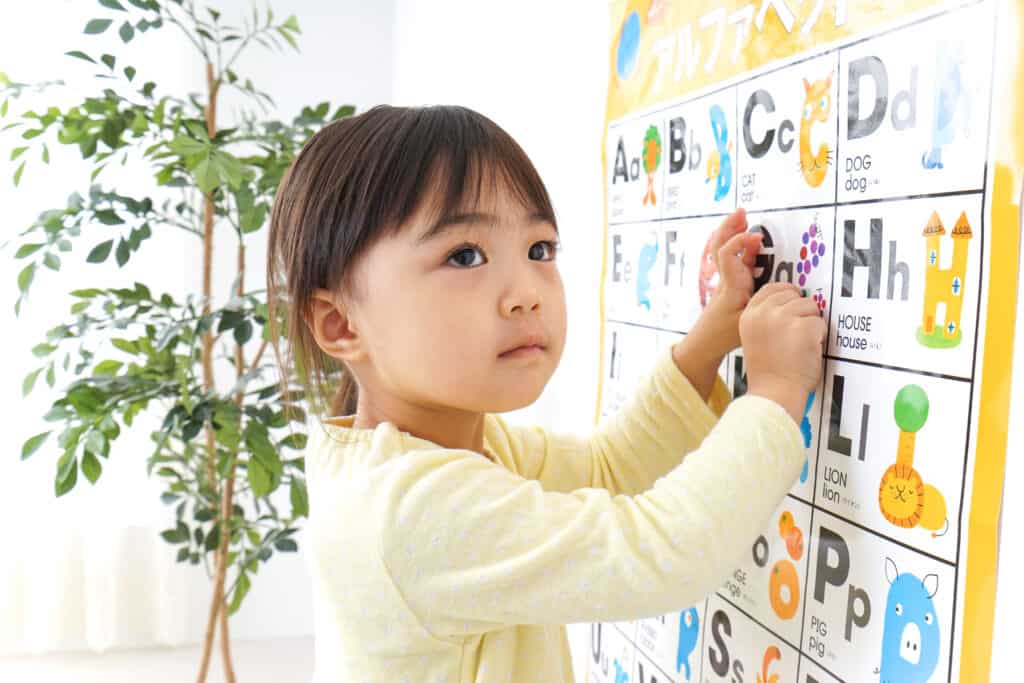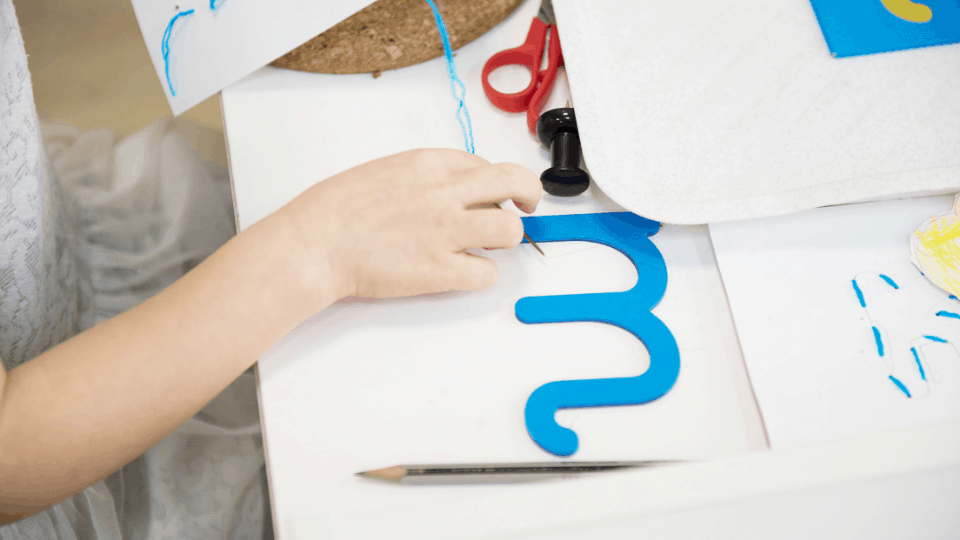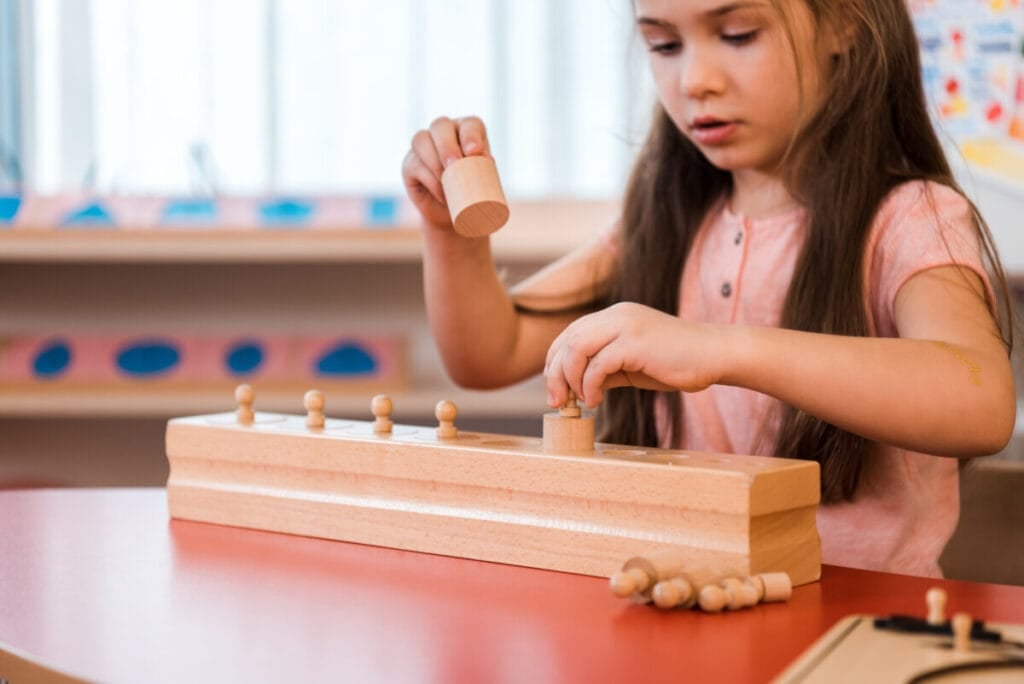
Montessori is a way of teaching children, especially at a young age, by focusing on the independence of the child. There are many benefits to teaching this way, but it is quite different from traditional schooling.
In
The
Montessori Ideals and Goals
Educating a child through
Montessori education has a unique focus on the child’s mental and physical abilities to learn.
The exercises give plenty of freedom to the child to do the work in a way that makes sense to them and it lets them teach themselves with outside instruction when needed.
The environment in which
How Montessori Teaches the Alphabet
Learning the alphabet is one of the very first things any child learns how to do, no matter the teaching method. It’s the starting skill that will enable children to read and write in the future. The
Montessori teaches the alphabet with a much greater emphasis on the sounds that the letters make.
Montessori teaches children in a way that prepares them for the next step in their learning while still fully covering the current topic. The exploration of the alphabet is a great example of this.
A Focus on Sounds
When learning to read, children often have a hard time making the connection between what the letters in the word are, and how to pronounce them. By learning traditionally, there is an unnecessary middleman of the letter name between the phonics and reading the word.
Children learning by
While the phonetics of letters are taught first, the letter names are not completely ignored. They are taught, but only after the letter sounds have been mastered to not confuse the child.

Changing the Order
The order of the traditional alphabet is arbitrary and has no purpose besides giving a more universal way of teaching it. The
There are several different orders of teaching the letters, but one of the most common orders, especially for beginning
- Set one: c m a t
- Set two: s r i p
- Set three: b f o g
- Set four: h j u l
- Set five: d w e n
- Set six: k q x y z
The letters are taught and ordered this way because of their phonetic relevance to each other. By learning consonants and vowels that are common in the same word, the child can learn as many words as possible while learning the letters. Some people worry about children not knowing the traditional alphabet order and being different from other kids their age, but through the world around them, they will learn the alphabet and it will not affect the way they have previously learned.
Tips for Teaching the Montessori Alphabet
There are a lot of little details to pay attention to when teaching the
- Introduce lowercase letters first. The priority when teaching
Montessori is to teach the most commonly used letters and words first. Because a child will more often see lowercase letters when reading, they should be able to recognize those symbols perfectly before learning to recognize capital letters, which they will see less often. - When teaching letters that have more than one sound, begin teaching with the most common sound first. Many consonants make other sounds, but by teaching the most common one sound first, the child will be able to read more words without confusion. With a letter like G, teach the “guh” sound before the “juh” sound because the child will encounter that sound more often and will feel more capable.
- Similar to how to teach consonants with more than one sound, it is best to teach vowels similarly. All vowels have multiple sounds, so start teaching with the short, common vowel sounds first like “ih”, “eh”, and “aah”. These come up more often and will be more useful and less confusing.
- When teaching the letter sounds, speak them lightly and clearly. It would not be very helpful for a child to learn the letter C as “KUH”, but rather as a crisp, light “k”.
- When teaching blends and digraphs, work through them slowly and make sure the child understands how combinations of letters work. For blends, have them try connecting the two letters without a break in sounds, like “mmmmaaaa”. When teaching digraphs like “sh” and “ch”, teach each brand new sound one at a time, making sure the child understands each sound well before moving onto the next one.
Application to Reading
While we have explained a bit how learning the alphabet this way helps with reading, there are a few more details that make reading easier for
The point that a parent wants their child to get to is understanding the correlation between the sound “aah” and the symbol “a”. The
Cursive is the preferred way of teaching writing, or encoding.
Unmentioned before, but beneficial to the development of reading skills, is the way
An imperative part of learning to read is understanding how to blend letters. When a child understands how to pronounce letters together, they are better able to make words. Cursive helps them see the relationships between sounds, but they can’t pronounce them without learning proper blending. Instead of CAT being “kuh”-“aah”-“tuh”, it needs to be understood as one whole word of blended letters without breaks.
Montessori focuses on Phonemic Awareness, which is a child’s ability to recognize and manipulate tiny units of sound used to make words. The teaching of the alphabet this way pays special attention to Phonemic Awareness which ultimately makes the child more capable of reading.
Activities and Tools for Teaching Montessori
While we have covered the ideas behind teaching the alphabet
Wooden Boards or Blocks
A highly recommended tool for teaching the alphabet is textured letters on wooden boards. The texture invites the child to trace the letter and develop memory for writing that letter. A great activity for strengthening your child’s recognition of the letters is to place the whole alphabet out, in no particular order, and have them place images or figurines of animals that start with that letter next to the wooden board. This helps them make better connections to practical uses instead of just memorizing the letters and their sounds.
Listen and Spot Game
Gather objects that begin with the sounds the child has already learned. Go through them one by one and say what they are so the child can hear the beginning sound. Once familiar with the names of the objects, ask the child to find the object that begins with the sound “k”. If the child picks up the correct object, a cup, toy cat, etc., then they understand those letters.
A Small Movable Alphabet
Having tangible letters as objects for the child to move can be a great benefit to them. It helps them really understand the shapes of letters instead of just the flat blocks. They also have the new opportunity to manipulate the letters to spell words. This is a great way to introduce them to blending sounds, as they will understand better that putting letters together makes words.

Tracing Letters with Objects
Another way to enforce the child’s understanding of how to write the letters is to give them a bowl of small, relatively even objects, and worksheets with dotted letters on them. Have the child use the objects (marbles, pebbles, dry beans, etc.) to trace the letter on the page. They will get more reinforcement for writing the letters and can practice hand-eye coordination as well.
Object and Letter Connection Game
A much larger version of the Listen and Spot game, this game is a great one for a child who has understood more sounds, or the whole alphabet. Place cards or mats with the letters on them, and gather a bucket full of objects starting with those sounds. The child has the opportunity to move from connecting animals to letters, to really having to listen for the sound and match brand new objects to the letters. By having several objects per letter, the child has to really understand the letter sounds instead of using the process of elimination to find where the objects go.
Implementing the Montessori Method
One of the great things about
Having a specific area in your home for teaching
Every parent should put in the effort to teach their child the alphabet, and the







